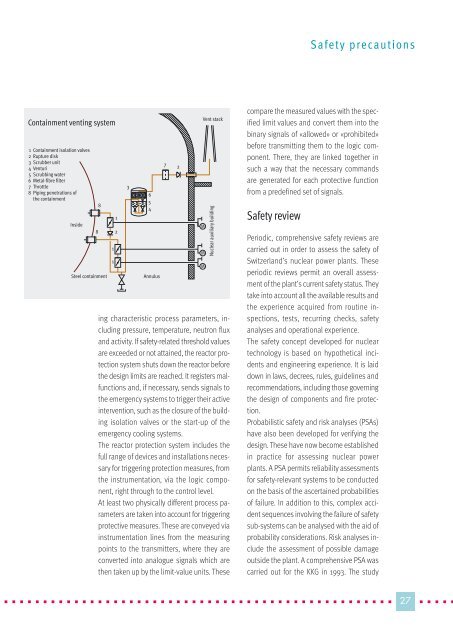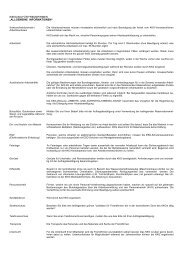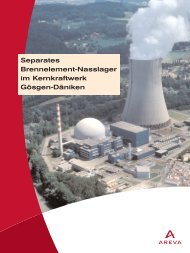Technology and Operation - Kernkraftwerk Gösgen
Technology and Operation - Kernkraftwerk Gösgen
Technology and Operation - Kernkraftwerk Gösgen
Create successful ePaper yourself
Turn your PDF publications into a flip-book with our unique Google optimized e-Paper software.
Containment venting system<br />
1 Containment isolation valves<br />
2 Rupture disk<br />
3 Scrubber unit<br />
4 Venturi<br />
5 Scrubbing water<br />
6 Metal-fibre filter<br />
7 Throttle<br />
8 Piping penetrations of<br />
the containment<br />
Inside<br />
8<br />
8<br />
Steel containment<br />
1<br />
1<br />
1<br />
2<br />
3<br />
6<br />
5<br />
4<br />
Annulus<br />
7<br />
ing characteristic process parameters, including<br />
pressure, temperature, neutron flux<br />
<strong>and</strong> activity. If safety-related threshold values<br />
are exceeded or not attained, the reactor protection<br />
system shuts down the reactor before<br />
the design limits are reached. It registers malfunctions<br />
<strong>and</strong>, if necessary, sends signals to<br />
the emergency systems to trigger their active<br />
intervention, such as the closure of the building<br />
isolation valves or the start-up of the<br />
emergency cooling systems.<br />
The reactor protection system includes the<br />
full range of devices <strong>and</strong> installations necessary<br />
for triggering protection measures, from<br />
the instrumentation, via the logic component,<br />
right through to the control level.<br />
At least two physically different process parameters<br />
are taken into account for triggering<br />
protective measures. These are conveyed via<br />
instrumentation lines from the measuring<br />
points to the transmitters, where they are<br />
converted into analogue signals which are<br />
then taken up by the limit-value units. These<br />
2<br />
Vent stack<br />
M<br />
M<br />
M<br />
Nuclear auxiliary building<br />
Safety precautions<br />
compare the measured values with the specified<br />
limit values <strong>and</strong> convert them into the<br />
binary signals of «allowed» or «prohibited»<br />
before transmitting them to the logic component.<br />
There, they are linked together in<br />
such a way that the necessary comm<strong>and</strong>s<br />
are generated for each protective function<br />
from a predefined set of signals.<br />
Safety review<br />
Periodic, comprehensive safety reviews are<br />
carried out in order to assess the safety of<br />
Switzerl<strong>and</strong>’s nuclear power plants. These<br />
periodic reviews permit an overall assessment<br />
of the plant’s current safety status. They<br />
take into account all the available results <strong>and</strong><br />
the experience acquired from routine inspections,<br />
tests, recurring checks, safety<br />
analyses <strong>and</strong> operational experience.<br />
The safety concept developed for nuclear<br />
technology is based on hypothetical incidents<br />
<strong>and</strong> engineering experience. It is laid<br />
down in laws, decrees, rules, guidelines <strong>and</strong><br />
recommendations, including those governing<br />
the design of components <strong>and</strong> fire protection.<br />
Probabilistic safety <strong>and</strong> risk analyses (PSAs)<br />
have also been developed for verifying the<br />
design. These have now become established<br />
in practice for assessing nuclear power<br />
plants. A PSA permits reliability assessments<br />
for safety-relevant systems to be conducted<br />
on the basis of the ascertained probabilities<br />
of failure. In addition to this, complex accident<br />
sequences involving the failure of safety<br />
sub-systems can be analysed with the aid of<br />
probability considerations. Risk analyses include<br />
the assessment of possible damage<br />
outside the plant. A comprehensive PSA was<br />
carried out for the KKG in 1993. The study<br />
� � � � � � � � � � � � � � � � � � � � � � � � � � � � � � � � � � � � � � � � � � � � � � � � � � �27 � � � � � � �




